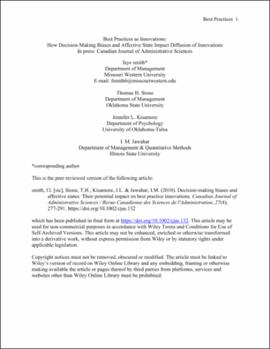| dc.contributor.author | smith, faye l. | |
| dc.contributor.author | Stone, Thomas H. | |
| dc.contributor.author | Kisamore, Jennifer L. | |
| dc.contributor.author | Jawahar, I.M. | |
| dc.date.accessioned | 2022-04-27T18:15:58Z | |
| dc.date.available | 2022-04-27T18:15:58Z | |
| dc.date.issued | 2010-09-20 | |
| dc.identifier.citation | smith, f.l. [sic], Stone, T.H., Kisamore, J.L. & Jawahar, I.M. (2010). Decision-making biases and affective states: Their potential impact on best practice innovations. Canadian Journal of Administrative Sciences / Revue Canadienne des Sciences de l'Administration, 27(4), 277-291. https://doi.org/10.1002/cjas.132 | en_US |
| dc.identifier.uri | https://hdl.handle.net/11244/335296 | |
| dc.description | This is the peer reviewed version of the following article:
smith, f.l. [sic], Stone, T.H., Kisamore, J.L. & Jawahar, I.M. (2010). Decision-making biases and affective states: Their potential impact on best practice innovations. Canadian Journal of Administrative Sciences / Revue Canadienne des Sciences de l'Administration, 27(4), 277-291.
which has been published in final form at https://doi.org/10.1002/cjas.132. This article may be used for non-commercial purposes in accordance with Wiley Terms and Conditions for Use of Self-Archived Versions. This article may not be enhanced, enriched or otherwise transformed into a derivative work, without express permission from Wiley or by statutory rights under applicable legislation.
Copyright notices must not be removed, obscured or modified. The article must be linked to Wiley’s version of record on Wiley Online Library and any embedding, framing or otherwise making available the article or pages thereof by third parties from platforms, services and websites other than Wiley Online Library must be prohibited. | en_US |
| dc.description.abstract | Rogers’s (2003) stages of innovation adoption and diffusion (knowledge of innovation, persuasion, decision, implementation, and confirmation) are used as a framework for understanding the decision-making biases and heuristics (i.e., anchoring, framing, confirmatory and availability biases, overconfidence, and representativeness) embedded in an organization’s adoption and implementation of best practices. Also, the role of affect on the diffusion of innovations is examined using the Affect Infusion Model (Forgas, 1995). Propositions are stated specifying effects of decision heuristics and affect on each stage of the diffusion of innovations. | en_US |
| dc.language | en_US | en_US |
| dc.subject | affect | en_US |
| dc.subject | best practices | en_US |
| dc.subject | decision-making | en_US |
| dc.subject | heuristics | en_US |
| dc.subject | innovation | en_US |
| dc.title | Decision-making biases and affective states: Their potential impact on best practice innovations | en_US |
| dc.type | Article | en_US |
| dc.description.peerreview | Yes | en_US |
| dc.identifier.doi | https://doi.org/10.1002/cjas.132 | en_US |
| ou.group | Dodge Family College of Arts and Sciences::Department of Psychology | en_US |
